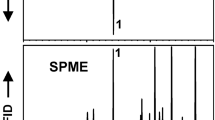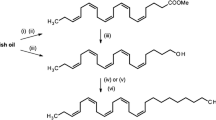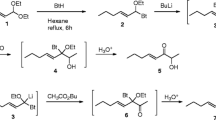Abstract
Electroantennogram analyses of female gland extract and of male antennal responses to synthetic standards suggested that (Z,E)-3,5-tetradecadien-1-ol acetate is a pheromone component for the carpenterworm moth,Prionoxystus robiniae (Peck). The four 3,5-geometrical isomers were synthesized and bioassayed in the laboratory and the field in 1972, 1973, and 1974. TheZ,E isomer was found to be active in the laboratory and a good attractant in the field. The synthesis of theZ,E isomer also produced considerable quantities of theE,E isomer, which is difficult to remove completely. TheE,E isomer does not inhibit the response of males to theZ,E isomer when it is present in amounts up to 20% of theZ,E isomer. The addition of a keeper, a volatility modifier, or an antioxidant prolonged the activity of the attractant for as much as 43 days. (Z,E)-3,5-Tetradecadien-1-ol acetate may be a natural pheromone, but it has not been chemically defined from female extract. There is EAG evidence that a second pheromonal component may be present. The attractant nevertheless provides a tool for population survey, behavioral studies, evaluation of economic impact, and possibly control.
Similar content being viewed by others
References
Celmer, W.D., andSolomons, I.A. 1953. Mycomycin. IV. Stereoisomeric 3,5-diene fatty acid esters.J. Am. Chem. Soc. 75:3430–3435.
Leppla, N.C., Solomon, J.D. andDoolittle, R.E., 1974. Culturing Lepidoptera: The carpenterworm,Prionoxystus robiniae.Ann. Entomol. Soc. Am. 68:683–685.
Lindlar, H. 1952. Ein neuer Katalysator für selektive Hydrierungen.Helv. Chim. Acta 35:446–450.
Rodin, J.O., Leaffer, M.A., andSilverstein, R.M. 1970. Synthesis oftrans-3,cis-5-tetradecadienoic acid (megatomoic acid), the sex attractant of the black carpet beetle, and its geometric isomers.J. Org. Chem. 35:3152–3154.
Roelofs, W., andComeau, A. 1971a. Sex attractants in Lepidoptera. Pages 91–114,in A. Tahori (ed.),Chemical releasers in insects, III. Gordon and Breach, New York.
Roelofs, W.L., andComeau, A. 1971b. Sex pheromone perception: Electroantennogram responses of the redbanded leafroller moth.J. Insect Physiol. 17:1969–1982.
Roelofs, W.L., Comeau, A., Hill, A., andMilicevic, G. 1971. Sex attractant of the codling moth: Characterization with electroantennogram technique.Science 174:297–299.
Silverstein, R.M., Rodin, J.O., Burkholder, W.E., andGorman, J.E. 1967. Sex attractant of the black carpet beetle.Science 157:85, 86.
Solomon, J.D. 1967. Rearing the carpenterworm,Prionoxystus robiniae, in the forest.Ann. Entomol. Soc. Am. 60:283–285.
Solomon, J.D., andMorris, R.C. 1966. Sex attraction of the carpenterworm moth.J. Econ. Entomol. 59:1534, 1535.
Solomon, J.D., Doolittle, R.E., andBeroza, M. 1972. Isolation and analysis of the carpenterworm sex pheromone.Ann. Entomol. Soc. Am. 65:1058–1061.
Solomon, J. D., Doolittle, R. E. 1976. Carpenterworm sex pheromone trap evaluation.Environ. Entomol. 5:502–504.
Trippett, S., andWalker, D.M. 1961. The phosphobetaines: Preparation and properties.J. Chem. Soc., 1266–1272.
Author information
Authors and Affiliations
Rights and permissions
About this article
Cite this article
Doolittle, R.E., Roelofs, W.L., Solomon, J.D. et al. (Z,E)-3,5-Tetradecadien-1-ol acetate sex attractant for the carpenterworm moth,prionoxystus robiniae (peck) (Lepidoptera: Cossidae). J Chem Ecol 2, 399–410 (1976). https://doi.org/10.1007/BF00988805
Received:
Revised:
Issue Date:
DOI: https://doi.org/10.1007/BF00988805




